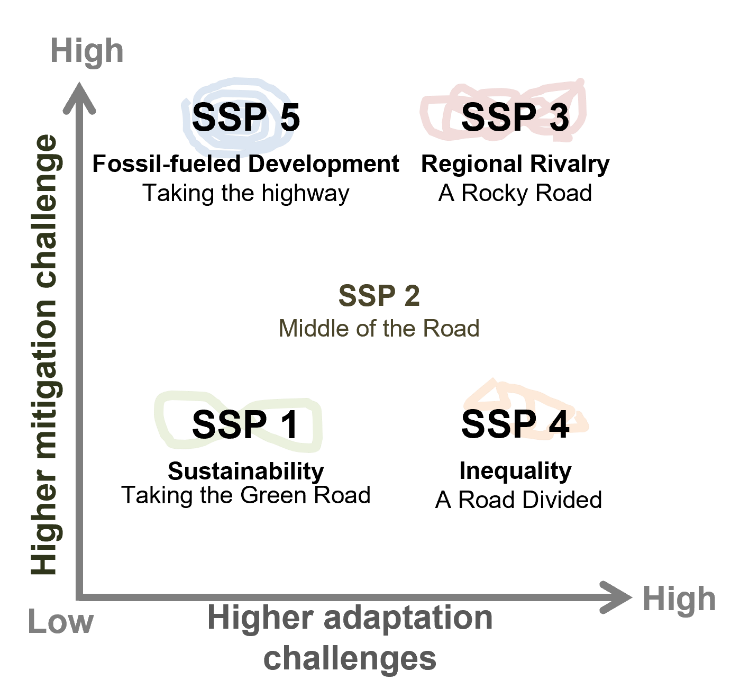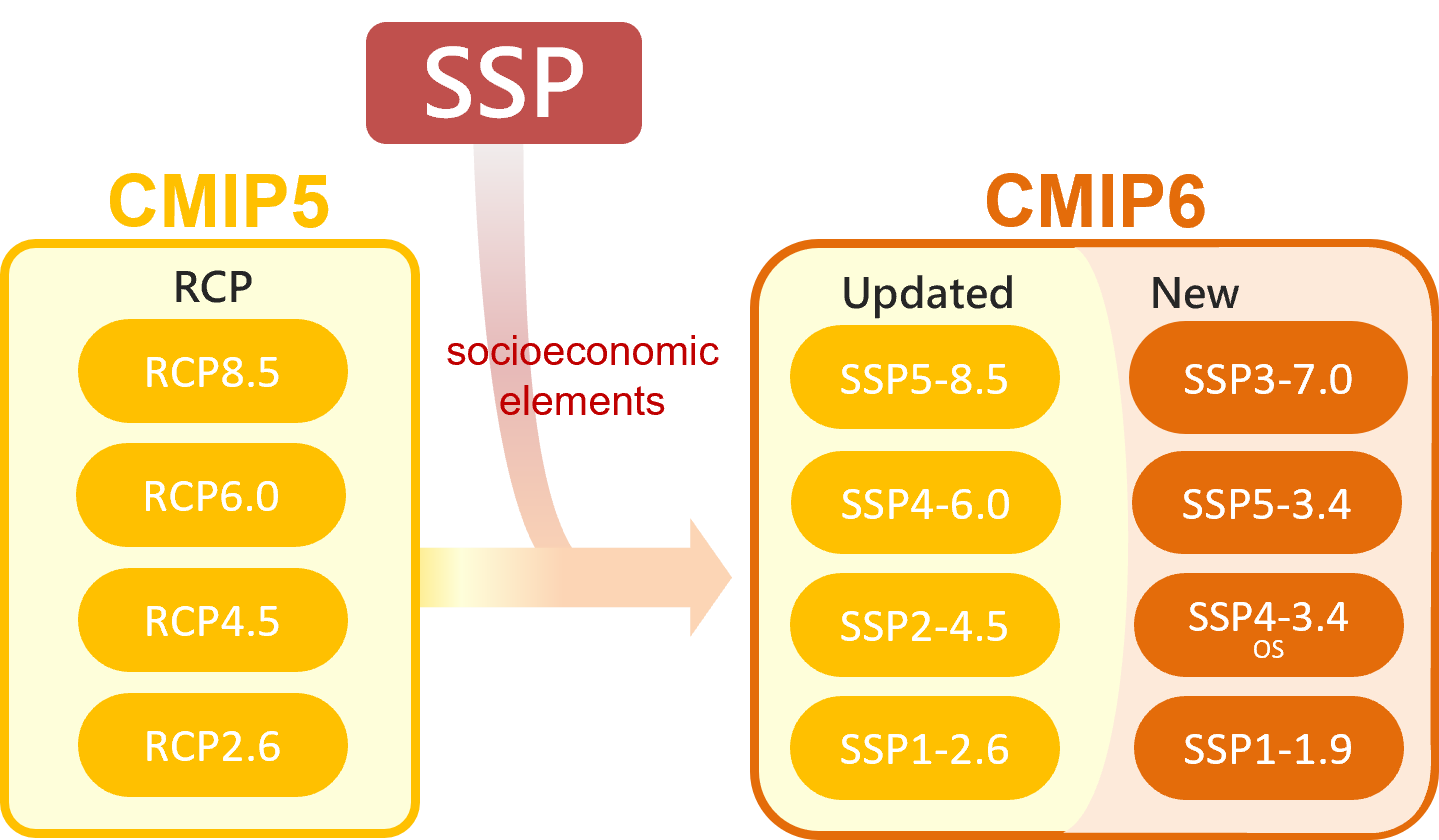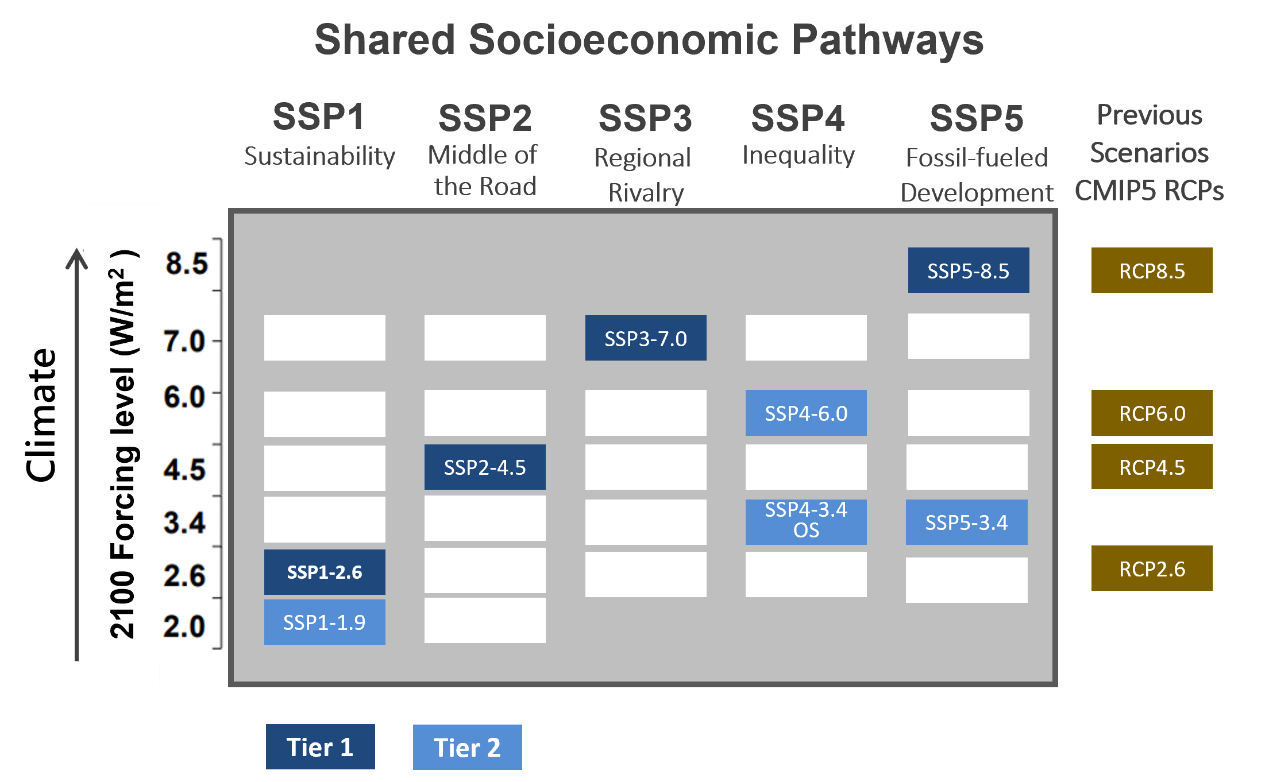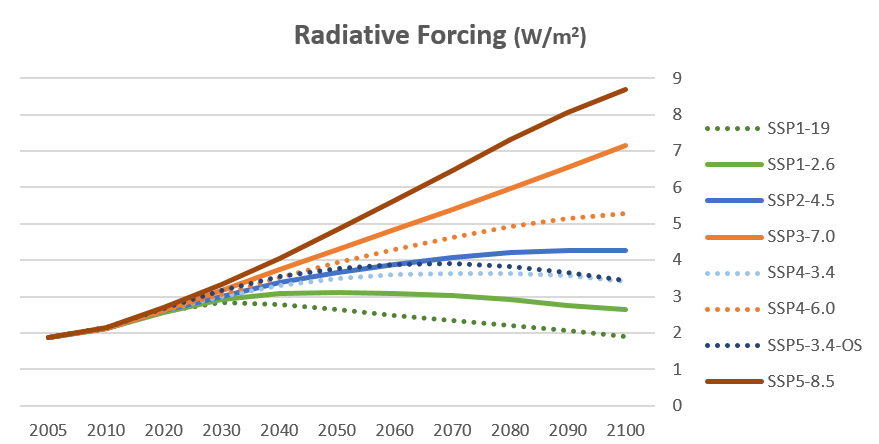Data Service / Projection
Shared Socioeconomic Pathway Introduction
IPCC released the Sixth Assessment Report (AR6) in 2021, the “Shared Socioeconomic Pathway (SSP)” was proposed by combining the results of multiple research communities from climate change research community internationally in order to set new climate change scenarios. The Representative Concentration Pathway (RCP) scenarios in AR5, which only considered changes in greenhouse gases are enriched as SSP incorporates social-economic development elements.
There are five scenarios SSP1, SSP2, SSP3, SSP4 and SSP5. The main differences between the scenarios are socioeconomic assumptions, such as economic growth, degree of globalization, land use changes, technological development, educational opportunities, etc. SSPs with different level of challenges from adaptation and mitigation is shown in Figure 1.

With the introduction of SSP, CMIP6 combines socioeconomic elements and radiative forcing and launches eight combinations of projections (SSP-RCP) (Fig2), including four updated scenarios and four new scenarios. Updated scenarios are to be the continuous observations of the past scenarios while new scenarios are to expand the exploration of future climate development.

The above scenario simulation design is divided into two phases (Tier 1 and Tier 2) according to priority (Figure 3). Each cell represents socioeconomic development paths and specific (feasible) radiative forcing in the Integrated Assessment Model (IAM). The dark blue cells represent the first-phase climate model scenario, the light blue cells represents the second phase, and the brown cells on the right represents the past RCP scenarios without socio-economic elements for reference.

The first phase of the simulation covers a wide range of radiative forcing path uncertainties of climate science, IAM, and IAV and provides key scenarios to anchor other experiments of model intercomparison projects (MIP). In this phase, updated scenarios include SSP5-8.5(RCP8.5), SSP2-4.5(RCP4.5), and SSP1-2.6(RCP2.6) as well as unmitigated scenario - SSP3-7.0 with high aerosol emissions and land use change. (Fig.4)
SSP5-8.5 is a high radiative forcing pathway. The reason for selecting this socioeconomic scenario is that SSP5 is the only SSP scenario with emissions high enough to reach radiative forcing level of 8.5W/m2 in 2100
SSP3-7.0 is a medium-to-high forcing path. SSP3 combines relatively high social vulnerability and radiative forcing. Since the past scenarios of no climate policy intervention in AR5 relied heavily on the RCP8.5 scenario. SSP3-7.0 in AR6 provides one more option for future climate analysis. Unlike SSP5-8.5, SSP3-7.0 has strong land use changes and high NTCF emissions.
SSP2-4.5 is the middle pathway. The reason to choose SSP2 is that its land use and aerosol paths are less extreme comparing to other SSPs, which is a combination of medium social vulnerability and medium radiative forcing.
SSP1-2.6 is a low radiative forcing pathway. The simulation reveals average results of lower than 2°C in 2100. SSP1 is selected because it has clear land use change with rising global forest coverage, meaning that the scenario shows a combination of low vulnerability, mitigation pressure and radiative forcing.
The second phase of the simulation includes other scenarios scientists are interested of, adding SSP4-6.0 (RCP6.0), two more scenarios realizing relatively low radiative forcing results (SSP4-3.4 and SSP4-3.4), and one overshoot path. (SSP5-3.4-OS).
While SSP4-6.0 updates the pathway of RCP6.0, it accomplishes medium radiative forcing pathway as well. In addition, SSP4-6.0 and SSP4-3.4 are comparable to study different radiative forcing path under the same socioeconomic circumstance.
SSP4-3.4 helps to resolve the gap of policy discussions on the mitigation path between RCP 2.6 and 4.5 in the past as the huge difference in emission reduction costs between these two scenarios. This compromise path therefore was added as the reference for policymakers.
SSP1-1.9 is the only radiative forcing pathway lower than RCP 2.6, aiming to limit warming to the pre-industrial level of 1.5°C by 2100, in response to the 1.5°C target of the Paris Agreement.
The SSP5-3.4-OS pathway explores climate science and policy implications of radiative forcing to peak and then decline in the 21st century. This pathway is similar to the SSP5-8.5 path in its early stage, yet takes a more complex approach after 2040. Strong emission reduction measures will reduce human-made emissions in the short term and reach the net zero target by 2070.

O'Neill, B. C., Tebaldi, C., van Vuuren, D. P., Eyring, V., Friedlingstein, P., Hurtt, G., Knutti, R., Kriegler, E., Lamarque, J.-F., Lowe, J., Meehl, G. A., Moss, R., Riahi, K., and Sanderson, B. M.: The Scenario Model Intercomparison Project (ScenarioMIP) for CMIP6, Geosci. Model Dev., 9, 3461–3482, https://doi.org/10.5194/gmd-9-3461-2016, 2016.
